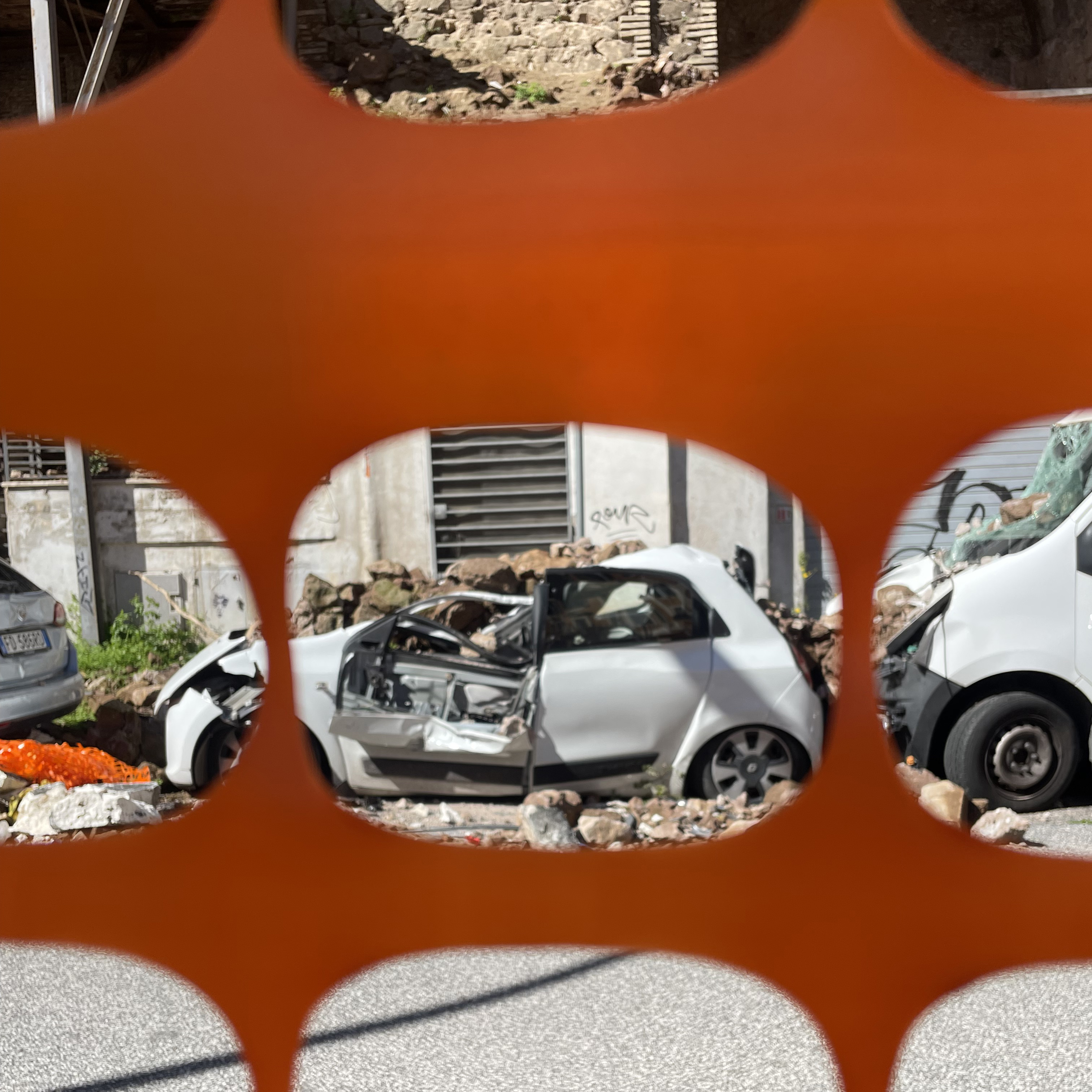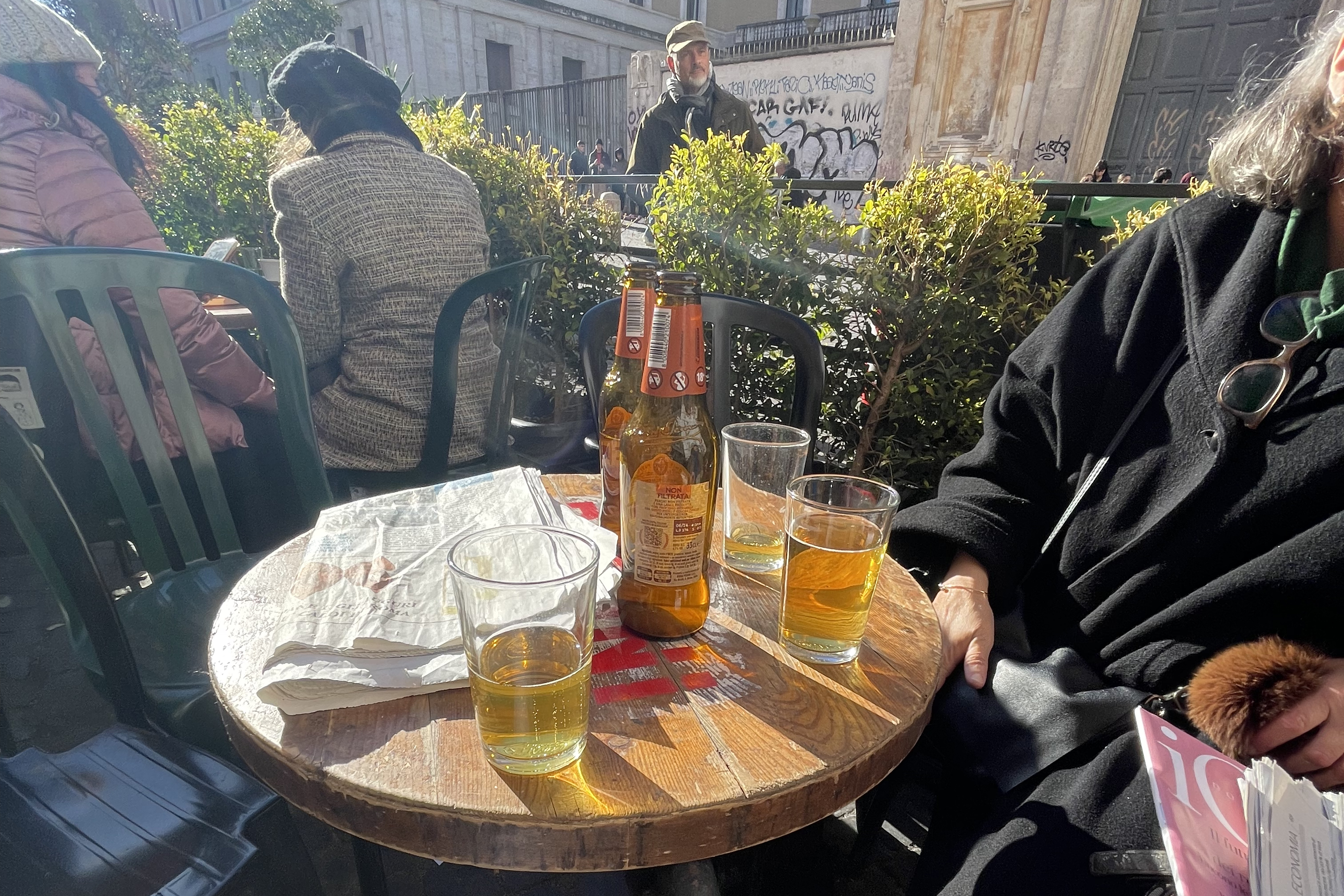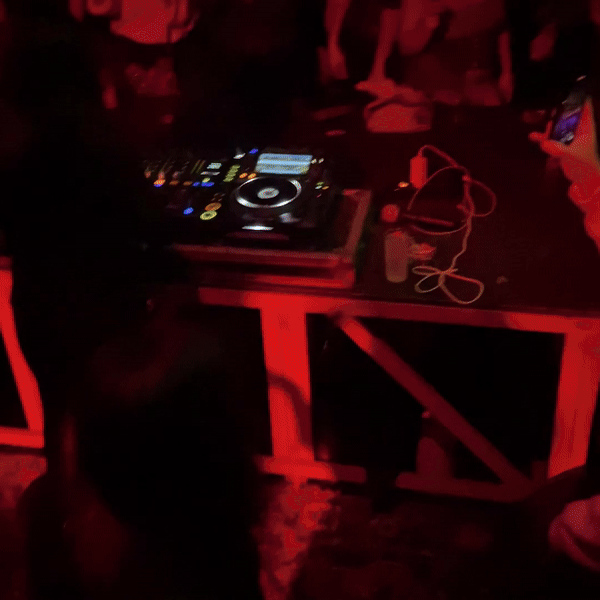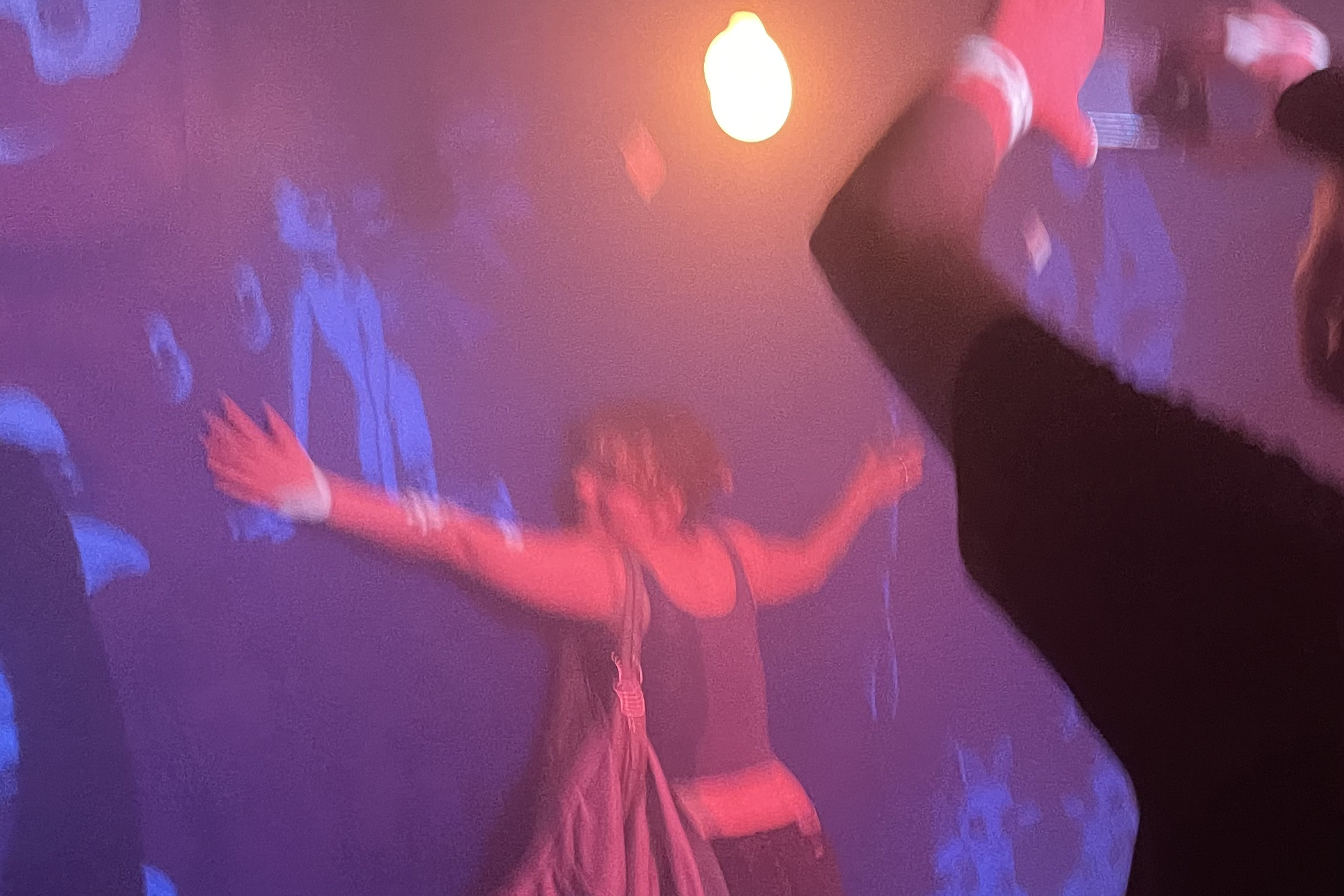Nightscenes part II
Marta Ceccarelli

I have been in Rome for almost 5 months now. I do miss the reliable public transport, the higher salaries, the music scene. But in exchange I have received sun, cheap food, hanging out at a bar, chatting with strangers, chaos, trash, roughness, empty space, occupied space, politics, churches, nuns, priests. My favorite product of the combination of these elements is casual sociality. A clichè but perfect example is my favorite bar which is also everyone’s favorite bar, San Calisto. It's in Trastevere, a 2 minute walk from my first room in Rome, the mezzanine. From my current spot it is 40 minutes by unreliable public transport, but I still try to visit. It's a third place, not home, not work. A place for leisure. Coffee and croissant: 1.90€, small beer: 1.50€. Full of life and characters, it changes with the time of day. Old men, locals, foreigners, tourists, students, young and unemployed movida. I go there and I chat with the New York millionaire who was a hippie in the 60s, a business owner in the 70s and a world traveler in his 80s, maintained by a lower east apartment he rents out for 20,000 dollars a month. I chat with the security manager of the children's hospital, who is 35 and just moved out of his mom's place. He tells me he’s been to Amsterdam for Amsterdam Dance Event. I chat with the barista, who has learned my very simple order, a cream cornetto and a cappuccino - oat milk doesn't exist in this world, so a regular one will do. What is consumed there, more than the copious amounts of coffee and alcohol, is a certain type of sociality: low stake and easy to enter. A sociality that is also much more present in the nightscene compared to the colder and clique heavy Amsterdam club environment. In Rome people on the streets and in the cafes and in the bars actually talk to you? Chances for meaningful (not necessarily only positive) interactions when stepping outside are high given the loudness and perpetual chattiness of the city.

SCENES OF THE NIGHTSCENE
What I noticed right away while going out here is that the crowd can easily be quite old compared to my previous standards. In general, people here are considered young until their early 40s, so you easily have audiences with fairly mixed age groups. Sometimes, the TikTok-esque nightmare clubs attract barely legal highschoolers who larp as an imprecise conglomeration of Dutch gabbers and Berlin ravers. A lot of the nightscene is in the hands of occupied spaces, centri sociali, and Circoli Arci [For the purpose of this article, I’ll attempt to explain in very simple terms what Arci’s are. Arci is a national association for recreational and cultural activities, in practice a circuit of associated places that can operate as bars, restaurants, music venues, libraries, event spaces, etc. Arcis politically lean towards the left and are close to causes of antiracism, LGBTQ rights, migrant rights, feminism, and other forms of social justice. You could say they occupy the space between formal businesses and occupied spaces. While they are “official” and not squatted, the type of public usually associated with Arci is close to the ones of occupied spaces. Rome has a very high amount of these Arcis, and much of its nightscene is based on three or four circoli in the city. To get in, you must have a membership, which comes with a yearly fee of €8,-, keeping the entry ticket to events quite cheap] because in Italy youth (music, political) cultures are constantly disincentivized by governments, local and national, by parent cultures, by employment, by university. To make space for oneself in a place so encrusted in traditional and mainstream commercialization is inherently politically charged. It feels like whose side you are on must be constantly repeated. Fascism lingers in the air and materializes through spray painted walls and roman salutes. So, images are repeatedly flipped on their heads: upside down, an hourglass waiting to be turned again and again. Ruins are ontologically both eternal and frail, at once things are stale and unstable: a city stuck in its own quicksand.
Rome’s history is the immovable force which renders it a city difficult to be rewritten by the latest trends of hip cultural renewal. The material artifacts that compose it have been exploited over and over again through tourism, in different waves of different kinds, but it is impossible to imagine that the city will ever escape that type of pull in favor for a more “cool” cultural one, the one that is sold in Amsterdam, Berlin, NYC, and now even Milan or Turin. Hence the capitalist style extraction that can operate in those contexts, has a hard time finding footing in a place like Rome [there are a few striking places because they look like they have been carved out from a north european/scandi capital and dropped in the middle of the city: Forno Conti feels and looks identical to Loof]. That does not mean that it doesn’t function as a neoliberal city - it does but in much more imperfect ways which maybe more honestly reveal capitalist contradictory nature. Rome is a place for janky capitalism.

Aesthetics here are present with much less homogeneity, less attention towards who they are (virtue) signaling to. The space is decorated for the immediate construction of a place. This is visible in the mostly ugly -sorry- posters of many events. Do not expect to find the now almost standardized graphic design of posters you see in Amsterdam, Brussels, London, NYC. People do not tend to dress similarly to each other according to the places they go to. Or they do a little bit, but you won’t ever enter a place like Kriterion [Amsterdam student run bar and cinema with some of the cheapest beer of the city and heavy second hand thrifted mullet bleached eyebrows skirt with jeans vibes], in which students are all dressed uniquely in the exact same way. Fashion is almost never a concern, a nice afterthought some occasionally indulge in.
One of the most representative events of Rome’s nightscene is Merende, hosted more or less once a month at Angelo Mai which is (I think) Rome’s biggest Circolo Arci. In simple terms, it’s an event that starts with talks and meetings and glittery make-up and tarot card readings and tattoos in the evening afternoon, leading to one or two DJ sets that go on until late at night. The central space where this happens is completely covered with carpets, so entry is allowed only after taking off one's shoes. “No machos no shoes,” is the motto. Sometimes, Merende falls on a Sunday. Weekends upon weekends spent in the various Arci’s around the city consolidate in a larger politicized chance for dancing. A whole bunch of weed, and a few other drugs too. Merende is an event that feels always on the cusp of turning into a “real party”, into a true full-on “club”, but it remains suspended right before it hits that point. The music, often unfortunately but endearingly badly mixed, seems like it is always almost going to drop. The DJs stop right before. Echoes of dubstep quickly and jankingly turn into afrobeat-esque techno, no linear musical direction. Perhaps it is in fear of transforming the party into a club – which here begins to feel like the enemy of the underground.

I have made the mistake of going to two club nights in Rome. It doesn't really matter which clubs they are, all “clubs” in Rome are comparatively quite bad. They follow the “club culture” that I had seen growing up in provincial Italy – 85% men, most of them grabby or annoying, occasionally updated with more “Berlin” “techno” outfits. Drug dealers sell chalky k in front of the security guards. Music isn’t awful, but the sound system is busted, and the drinks are 10€. The clubs with a bit more money might invite international artists but end up ignoring the knowledge gap necessary for their enjoyment. From talking to people here what emerges is that there's not really space or money for things to go beyond small local artists. A proposed solution for clubbification in Italy follows the Milanese model for events, where big money from big fashion is poured into decently big names. Similarly, the Turin Club2Club appears as the Italian mecca for club culture, but it once again presents a heavy institutionalized vibe, police dogs trying to sniff out drugs outside, safe consumption stands inside. Other places try to be Berlin, even though Berlin is 1) dead 2) not Rome. And as you can tell, my observations on urban cultural production and music often lead back to the idea of locality and authenticity. I get frustrated when other places try to be anything but the place they actually are. When club culture is a metaphor for some other distant thing that we are supposed to like, supposed to know, an unknown signifier represented through a misdrawn sign.
If this is club culture, then I don’t want it.
If club culture is a wall of men on the dance floor looking for girls to pester, if club culture is spending all my paycheck on drinks ubers drugs tickets memberships, if club culture is running around in circles desperately attempting to find a community that is just not there, then I don’t want it. I would rather spend my evenings playing foosball in an Arci, in a cloud of joint smoke, shitty speakers, fun and free interactions. I rather not engage mindlessly in a club culture the way I felt I was doing Amsterdam.
That is also because the city does not, in my opinion, have a healthy model of club culture. The Netherlands does not lack [laak] the heavy masculinity I associate with the Italian club world. And while the music scene is productive and vibrant, it feels to me that it often contributes rather than soothe neoliberal alienation and dissimulation. Sometimes going out in Amsterdam feels like chasing the perfect but unreachable combination of good music, good crowd, familiarity and randomness, openness to the unfamiliar. This is a fool’s errand, for this magical combo rarely truly occurs. Here, in Rome, I was looking for the places and the people who would help replicate that (unrealistic) image of club culture. But if you can’t replicate it, and if it did not exist in the first place, why chase it?
At the end of last year, I went to this thing called La Bagarre. I say a thing, because calling what they do or who they are a collective, a movement, a rave, a party, is all reductive or partially incorrect. In practice, they have an Instagram page, they randomly announce a date, provide its location on Telegram, and improvise a form of a party out in the street, in a square, in a park. The one I went to was in the garden of an occupied space within La Sapienza - the biggest university of Europe. Tall (ugly) modernist buildings surrounding a patch of grass where a mass of bodies gathered to chill, drink, talk, dance. Other times they have walked through the streets of Trastevere (now a very commercial old historical neighborhood), tormenting the mafia owned fake local restaurants filled with Americans and other clueless tourists. As they walked by, they stole pieces of pizza from the tables.

La Bagarre is not an event series, it is not a party even, it is also not a rave. It stems from an imminent need to be together on the street, with friends, some music, some alcohol, maybe the most pure and simple form of being together. In its past occurrences, La Bagarre occupied the urban landscape, deciding not to be tucked away behind the walls of a club but to be directly on the street. I talked to one of the people behind La Bagarre. He sent me a sort of manifesto they had written when they first tried to figure this Bagarre thing out and we had a nice long chat about all things Rome nightscene, a precarious map to guide me as I walk around this new environment. As always, these types of overviews of a city's nightscene are to be taken as partial and temporary; any attempt at drawing clear borders are attempts at stabilizing something that cannot and should not be immortalized as static.
But what became clear from this map, is the importance of the street, of the square, of the third place as jointure point. The role of the club of nurturing cultural segmentation and socialization according to taste does not have to be relegated to that institution. La Bagarre exploited the potential of italian’s habit of occupying the street to be exist in community. If clubs are a no-go for the ideological implications they carry with, and if raves are a no-go for their displaced, hidden, away from the center nature, then the answer is the visible space. It is there that you can see the people that surround you, to be present embodied vigilant open connected. La Bagarre recognizes the failures of the ghosts of counterculture, the ones that have brought us to a standstill, stuck in the false dichotomy of an underground vs mainstream. It understands the history of such countercultures, but says that theirs, and maybe I should say ours, is a whole different war. If we have been thought that all we are is a consumer, then we shall pick the goods, the objects of our capitalist desire. If we are doomed to lose ourselves in indulgence, let us do it with love. They don't want to be anyone except human bodies linked in the real abstraction of an object - guided by the eternal hope of being nothing.
Of course, I still have a lot of exploring to do here. It takes a bit to find the vein of a nightscene. But if you follow the deconstructed, glitchy, rough and unpredictable heartbeat of the city, you might find yourself in a place that feels full of potential, finger on the pulse. The advantage of a scene that is still brewing and bubbling and not yet ripe is that little gems seem to appear everywhere. Some might mature into flowers, some might even make it to fruits, some, if lucky, will become so plum so soft and sugary to pass the ripe point into being straight up cloying. Or maybe a big storm will come and tear down the trees and new ones will have to emerge and start the process once again. Always on the cusp of the drop.
SHORT DETOUR: I AM ALSO ON THE CUSP OF THE DROP BUT I DON’T WANT TO GIVE IT AWAY I WANT TO TALK ABOUT SOMETHING ELSE
A big while ago I was in London at venue MOT listening to an almost ambient set by Organ Tapes. A super stripped-down performance of songs blending and bleeding together, an incredibly moving experience. Somewhere in the set, I heard the sentence “to burn out or to rust”. Or at least I think I did, and I think it was Organ Tapes himself singing it. But then again, I have not been able to reconnect that sentence that I thought I heard so clearly to any of his released songs [if you hear it/know it, send it through]. Is there a chance I imagined this, lost in the foggy acoustic soundscape of a cold London evening? Maybe. [This distinction is also something Emma Glenn Baker talks about in her totally-unrelated-to-this-article podcast Stargirl, the classifications of ripe and dead] Since hearing that sentence at MOT I have been thinking so much about the dichotomy, the question of whether to burn out or to rust. I have tried to write about this in different contexts, but now I feel that the question could and should be asked when thinking about the life cycle of (sub)cultures.
How does a cultural thing(™) die? Which objects, experiences, sets of knowledge, systems of symbols or languages belonging to a “community”group”scene”niche” burn out and which one rust? Can a whole scene slow down so much to encrust itself in its own stasis to the point of rusting? Can a whole scene expend all energies outwards, forgetting its own needs to the point of burning out? Is one better or worse than the other? Does one necessarily exclude the other? The question of the death of a scene is necessary and hard to answer. When engaging in exercises of cultural analysis and criticism it is inevitable to hit a wall: the one of constant cultural reappropriation and hence, in many ways, death of the (sub)cultural object at hand.
It’s a wall because: while it is absolutely true and important to investigate the various ways in which let’s say music culture within an urban landscape might be usurped and corrupted through processes relating to cultural capital turning into capital proper, it is also now a bit boring and redundant to stop ourselves at this point of analysis. If it is true that neoliberal capital will recoup products of the avantgarde/underground/alternative layer of culture for its own benefit, and if then it is true that any effort of being avantgarde/underground/alternative remains futile in the face of this capitalist realist goop, then! much better reason to just keep pushing and keep doing whatever one wants, even if the inevitable result is becoming obsolete, or worse - becoming the enemy. Then any inquiry into culture that looks at its overarching lifespans and modes of confrontations with an enemy called “mainstream”, should peek into ways of dying, modes of confrontations with ends, to allow for new beginnings. Take example from Rome, which understands its immortality in its constant rebuilding onto ruins, the eternal city. If Amsterdam is going to die, let us pull the plug and start again, use the decaying culture as fertilizer.
CONTINUING ON THIS WAVE OF OBSERVATIONS OF CULTURE AS ORGANIC MATTER
My good friend Amie told me that music scenes are like wine, as in, provenance and terroir matter. The local dimension of a scene is integral to its ‘flavor’. Globalization has tricked us into partially believing that music itself has no borders or is not as restricted by territorial physicality, when it comes to its production and consumption. In many ways streaming platforms have flattened geographical granularities of music discovery: it is no longer necessary to have a good record shop in your town for you to have access to libraries of music, which have become now infinite, readily accessible, and dictated by algorithms. However, in this liberalized mode of consumption of music, gaps of embodied knowledge become more evident. The knowledge one builds from being in a place in a scene in a club in a social center in an occupied space in a rave - knowledge that moves and is dynamic and changes and bleeds into proximal spaces - is ultimately inherently embodied.
What I find evident, amongst my old friends and amongst my new connections here and amongst everyone I encounter in every city regardless of size and country, is a relentless need to connect – a need that is bottle necked and stunted by the inability to understand how to. Don't we all feel like - to a certain extent - we are lonely or disconnected? Yes, we might have friends or lovers or close connections, but the feeling of the body-to-body collective experience I believe remains the nirvana many of us want to achieve and can only do so on a few occasions. Music is the medium I have found aiding this the most for me. Sometimes we find it in ambient listening sets, sometimes in your friend’s car speeding through the highway, sometimes during a house party when you play the right tune and everyone gets hyped, sometimes at the club, sometimes at the rave, sometimes on the street through shitty speakers. An urgent and constant and global and local and relentless need to find connection. Through bodies, ideas, in spaces, at home, but not online.
Perhaps a small departure from the general topic or theme of this article – but what I would really like to lean into and tell everyone and to achieve myself is a process of at least partial disillusion with the internet, with onlineness. I feel the need to reject its proposed sociality. It's tough to get out of it, but maybe necessary to develop a better relation to that medium so that it does not eat the real alive. And this does not mean fully rejecting the internet. But to understand it as a means to an end which is necessarily embodied, physical, not virtual.
Also, with all of these ramblings, I am not trying to make a claim over the superiority or inferiority of one city’s ways of doing or nightscene over the other. The point of these observations and critical cultural analysis is to deepen our relationship and responses to culture itself, more specifically the one we participate in on the ground, with our friends.
To materialize our desire for connection, to start a real-life conversation about the waters we swim in, to adorn our environment with observations, "activating" its potential as a source of connection. The outcome of writing this, or anything I have ever written, is to hopefully begin a conversation, begin a connection, begin a friendship. Tell me what you think! Disagree with me! Let's go party together! Body to body, mind to mind.
